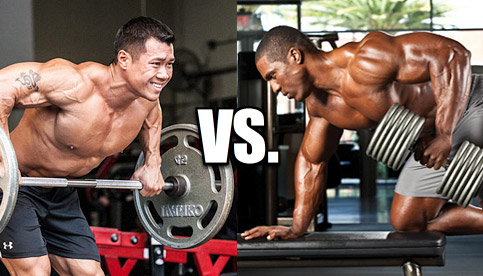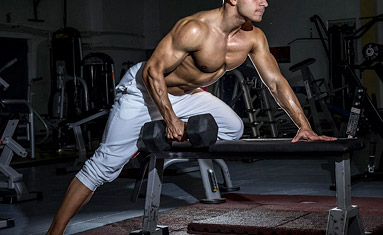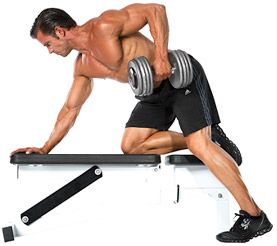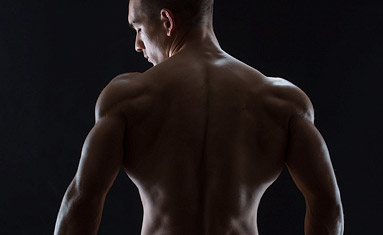BARBELL ROW VS. DUMBBELL ROW: WHICH IS SUPERIOR?

A well-rounded muscle building workout plan isn’t complete without a basic horizontal pulling movement thrown into the mix.
Free weight rowing exercises are a great way to build up the size and strength of the lats and mid-back, as well as providing secondary stimulation to other smaller muscles such as the biceps and rear delts.
But which is the superior choice between a barbell row vs. dumbbell row for muscle building purposes? Are they both equally effective or is there any reason to favor one over the other?
In this post I want to give you a few reasons why the dumbbell row is actually the better option between the two when it comes to stimulating the back for hypertrophy as well as minimizing the risk of injury…
Barbell Row Vs. Dumbbell Row: Why Dumbbells Are The Winner

Before I go further, let me first clarify that I’m certainly not saying that a barbell row is a “bad” exercise or that you cannot or should not perform it as part of your workouts.
There are obviously plenty of successful lifters out there with impressive backs who use barbell rows in their programs, and there’s no question that they’re an effective movement when done correctly.
However, if we’re talking about making the optimal choice between the barbell row vs. dumbbell row for maximizing hypertrophy, there are a couple of reasons why the barbell row comes up short between the two.
The primary drawback of the barbell row for muscle building purposes is the additional effort and focus that must be exerted just to maintain proper posture throughout the exercise.
Since you’ll be standing in a bent over position holding a loaded bar off the ground without any chest or lower back support, your spinal erectors, glutes, and hamstrings all must kick into high gear just to keep your body in position for the duration of the set.
This reduces the amount of focus that you can place on what really matters throughout the lift, which is providing maximum stimulation to your lats and mid-back muscles.
In fact, during a standard bent over barbell row, many lifters are forced to stop the set not because their lats and mid-back muscles are truly giving out, but rather because of excessive fatigue in their legs and lower back.
Some people will claim that this is actually a benefit of the barbell row because it turns the exercise into a more “functional movement” by involving the posterior chain, but I don’t see how this is a valid argument in favor of the lift.
If you’re already performing variations of the squat, deadlift, and other posterior chain exercises as part of your plan, then this area is already being trained effectively and there’s really no reason to be using a barbell row for that purpose.
If your primary aim in the gym during your back workouts is to build your back, then your choice of exercises should obviously be centered around that goal.
On top of this, if you are performing squats, deadlifts, and/or other similar “lower back intensive” exercises throughout your training week, you’ll want to keep your lower back as fresh as possible for those exercises.
Fatiguing your lower back on other movements such as the barbell row doesn’t really make sense, as it will only serve to reduce your strength on those big compound lifts.
For all of these reasons, I suggest using the one-arm dumbbell row as your main go-to free weight rowing exercise.
This rowing variation will keep your lower back and legs supported throughout the lift and allow you to place 100% of your focus where it should be, which is training your lats and mid-back as effectively as possible.
On top of reducing lower back fatigue throughout the week, the one arm dumbbell row will also minimize your chances for lower back injury as well since less strain will be placed on the area during the movement.
Since this is an iso-lateral exercise where each arm is trained independently, one final added benefit is that it will help to prevent size and strength imbalances since one arm can’t cheat for the other.
Here’s how to go about performing the one-arm dumbbell row with proper form…
How To Perform The One-Arm Dumbbell Row
There are several different one-arm dumbbell row variations that you could perform, but this is how I personally prefer to do them…
1) Setup an incline bench at around a 30-45 degree angle.
2) Stand behind the bench with your feet about shoulder-width apart and knees slightly bent, and hold onto a dumbbell using a neutral grip with your outer hand.
3) Press your other hand into the bench to support your upper body.
4) From there, row the dumbbell up toward your waist until you feel a strong contraction in your lat and mid-back muscles. Lower the dumbbell back down until your arm is extended toward the floor and repeat.
Here are a few additional tips to improve the effectiveness of the one-arm dumbbell row further…
- In order to maximize the tension on your back muscles rather than your biceps and shoulders, focus on rowing the dumbbell up using your elbow rather than your hand. Imagine that your hand and forearm don’t even exist, and just place 100% of your focus on driving the weight back using your elbows.
- Make sure to row the dumbbell at a slight angle rather than straight up and down as this will further increase the stimulation of the back muscles.
- As you row the dumbbell toward yourself, focus on squeezing your shoulder blades together as well.
- To increase the activation of your back muscles even further, you can use a set of lifting straps or lifting hooks to fully eliminate your grip from the equation.
Another option is to perform your one-arm dumbbell row using a flat bench, placing both your inside arm and knee onto the bench for support with your other leg out behind you…

Either variation is fine and you can simply use the one that feels most comfortable for you.
Two other dumbbell rowing variations you can try out that keep both the chest and lower back supported while allowing you to row both dumbbells at the same time are the dumbbell seal row and the incline-chest supported row which I’ve covered in previous posts.
Barbell Row Vs. Dumbbell Row: Quick Recap

Although barbell rows will still be an effective means of training your back when done correctly, the one-arm dumbbell row provides the following benefits:
- Allows you to direct all of your focus onto training your lats and mid-back without having to use up additional energy from your legs and lower back in order to maintain proper posture.
- Prevents lower back fatigue which keeps the area fully recovered and at maximal strength for big compound exercises like squats and deadlifts.
- Reduces the chances for injury since the lower back is supported throughout the exercise (read more about injury prevention tips).
- Prevents size and strength imbalances by allowing each arm to work independently so that one side can’t cheat for the other.
If you don’t have access to heavy enough dumbbells (or if you prefer barbell rows for some reason) then that’s fine, but given the choice between the two, I’d suggest using a one-arm dumbbell row as your primary free weight rowing movement for the reasons listed above.
If you found this article helpful, make sure to sign up for your FREE custom fitness plan below...




